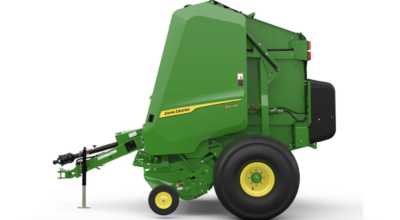Summer baling is all about timing. Miss the right window, and moisture climbs, nutrients drop, and spoiled bales start to stack up. With heat, humidity, and narrow harvest windows working against you, precision matters more than ever.

That’s where smart baling comes in. John Deere’s latest baler technology uses sensors, automation, and in-cab controls to take some of the pressure off. From optimizing bale moisture to adjusting windrow overlap automatically, it’s designed to help you make better bales faster, while reducing strain on your crew and your equipment.
Let’s look at how these tools are reshaping the hay season and what they could mean for your operation.
What Is Smart Baling?
Smart baling combines modern baler technology with field-ready automation. Sensors and digital tools track moisture, weight, bale count, and density while the machine is running. Instead of relying on constant operator adjustment, the baler uses live feedback to improve performance in real time. Here are a few of its key features:
Sensors That Monitor While You Work
Moisture and weight sensors mounted inside the baler help you make decisions on the go. They help ensure hay is not baled too wet or too dry, which can reduce spoilage, protect feed value, and improve overall bale consistency.
Bale Doc and Bale Mobile
Bale Doc is John Deere’s integrated bale documentation system that tracks bale moisture and weight in real time. With Bale Doc, you can automatically log bale data from the field. This includes total yield, average density, and moisture content, all tied to GPS location. Paired with the Bale Mobile app, this data can be accessed from the cab or mobile device, making it easy to adjust and track performance in real time.
Weave Automation
John Deere’s weave automation helps correct windrow overlap by adjusting the tractor’s path as it moves. This improves bale shape and reduces the chances of inconsistent density. It also reduces the number of manual steering corrections you would need to make throughout the day.
The Advantage of Automation During Summer Baling
Successful summer baling requires close attention and significant effort. You’re chasing dry weather, monitoring crop conditions, and keeping machines running at peak output all within a tight seasonal window. Smart baling technology helps ease that pressure by adding consistency and control where it matters most.
More Consistent Bale Quality
Even in perfect weather, maintaining uniform bale density can be a challenge. Windrows vary in size and shape. Fields don’t always cooperate.
Smart balers respond to those changes automatically. By adjusting pressure and feeding rates in real time, they help you produce tightly packed, even bales that stack easier, store better, and reduce waste down the line.
Better Timing on Moisture
Moisture levels can shift by the hour. Smart balers take the guesswork out of deciding when to start or stop work by tracking moisture as the crop moves through the chamber.
That means you can get started earlier in the day or push later into the evening, knowing exactly what’s going into each bale. This avoids spoilage risk from hay that’s too wet or too dry.
Fewer Inputs from the Operator
Manual steering corrections, constant lever adjustments, and second-guessing bale shape all add up over a long shift. With features like weave automation and in-cab display control, operators can focus more on overall field conditions and less on repetitive tasks. That reduces fatigue and improves accuracy, especially during high-pressure runs.
Better Field-Level Data
Accurate field data is essential for post-season planning. With Bale Doc and Bale Mobile, you can track bale counts, average moisture, and yield by location using GPS data. This helps you manage inventory more efficiently, make smarter storage decisions, and evaluate field performance with greater precision.
Equipment That Supports Smart Baling
John Deere’s smart baling features are available across several models, giving you the flexibility to find a system that fits your size and workflow.
1 Series Round Balers
The 1 Series round balers are well-suited for midsize operations looking to integrate smart features without overcomplicating their workflow. These balers include moisture sensing, consistent bale shaping, and user-friendly controls that help you stay productive without adding unnecessary complexity.
L341R High-Density Large Square Baler
The L341R is built for operations that demand more output per acre. This model produces dense, uniform square bales with faster wrap cycles and stronger feeding systems. It fully supports G5 displays and John Deere automation features, which means you can monitor performance, adjust settings, and log bale data from the cab.
G5 Displays and ISOBUS Compatibility
G5 displays serve as the control center for John Deere’s precision tools. These displays offer a clear, responsive interface that makes it easier to adjust settings, view diagnostics, and manage bale documentation in real time. ISOBUS compatibility ensures that your smart baler integrates cleanly with a wide range of tractors, so you can get the full benefit of automation without needing a full equipment overhaul.
Is It Time to Upgrade Your Baler?
Even if your current baler still runs reliably, you might be leaving optimal performance on the table. If any of these issues sound familiar, exploring newer baler technology could help:
- Moisture levels are inconsistent across bales
- Operators need to make frequent manual adjustments
- Bale documentation is tracked manually or post-season
- Productivity drops off during longer shifts
Even incremental upgrades in moisture monitoring or bale tracking can lead to better results by the end of the season.
Ready to Rethink the Hay Season?
When the pressure is on and the window is short, smart baling helps you stay ahead. With the right tools, you can make better bales, adjust to changing conditions faster, and stay productive without pushing your equipment, or yourself, to the limit.
To explore used John Deere balers with smart automation tools, visit your local John Deere dealer.



